SpringBoot Web开发:
springboot到底帮我们配置了什么?能不能修改,能修改哪些东西?能不能拓展
- xxxxAutoConfigurartion…向容器中自动配置组件
- xxxxProperties:自动配置类,装配配置文件中自定义的一些内容
要解决的问题:
- 导入静态资源…
- 首页
- jsp,模版引擎Thymeleaf
- 装配扩展SpringMVC
- 增删改查
- 拦截器
- 国际化
1、静态资源的存放目录:
我们在做以前项目的时候,有WebApp下可以放静态资源以及页面,SpringBoot中没有webapp了静态资源应该怎么放置呢?
- 在springboot,我们 可以使用以下方式处理静态资源
- webjars
localhost:8080/wbjars/ - public, static,/**,resources
- webjars
- 优先级:resources>static>(默认)>public
WebMVCAutoConfiguration:可以看到webjars是通过以下路径来找到
@Override protected void addResourceHandlers(ResourceHandlerRegistry registry) { super.addResourceHandlers(registry); if (!this.resourceProperties.isAddMappings()) { logger.debug("Default resource handling disabled"); return; } ServletContext servletContext = getServletContext(); addResourceHandler(registry, "/webjars/**", "classpath:/META-INF/resources/webjars/"); addResourceHandler(registry, this.mvcProperties.getStaticPathPattern(), (registration) -> { registration.addResourceLocations(this.resourceProperties.getStaticLocations()); if (servletContext != null) { registration.addResourceLocations(new ServletContextResource(servletContext, SERVLET_LOCATION)); } }); }
Resources:是通过以下四个目录来找到静态资源
private static final String[] CLASSPATH_RESOURCE_LOCATIONS = { "classpath:/META-INF/resources/", "classpath:/resources/", "classpath:/static/", "classpath:/public/" };
SpringBoot项目的静态资源文件夹的优先级:
创建了三个文件名相同的文件,测试它们的优先级
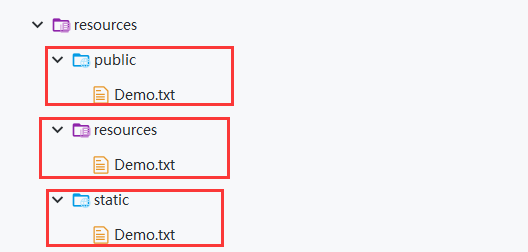
测试得到:resources目录 > static目录 > public目录
2、网站首页存放目录
将index页面放到静态资源目录:即上面的三个文件夹!优先级也是跟上面一样~

自定义默认网站图标:
1、将图片改为favicon.ico
2、放在static目录下
3、在application.yaml中添加,因为我使用的版本提示弃用的配置属性,不过不用管,可以运行成功!
spring:
mvc:
favicon:
enabled: false
4、访问首页即可看到!
我使用的是SpringBoot2.4.2,直接把ico图片放在static目录下,会自动识别
3、☆模板引擎
前端交给我们的页面,是html页面。如果是我们以前开发,我们需要把他们转成jsp页面,jsp好处就是当我们查出一些数据转发到JSP页面以后,我们可以用jsp轻松实现数据的显示,及交互等。jsp支持非常强大的功能,包括能写Java代码,
但是呢,我们现在的这种情况,SpringBoot这个项目首先是以jar的方式,不是war,像第二,我们用的还是嵌入式的Tomcat,所以呢,他现在默认是不支持jsp的。
那不支持jsp,如果我们直接用纯静态页面的方式,那给我们开发会带来非常大的麻烦,那怎么办呢,SpringBoot推荐你可以来使用模板引擎。
那么这模板引擎,我们其实大家听到很多,其实jsp就是一个模板引擎,还有以用的比较多的freemarker,包括SpringBoot给我们推荐的Thymeleaf,模板引擎有非常多,但再多的模板引擎,他们的思想都是一样的,什么样一个思想呢我们来看一下这张图。
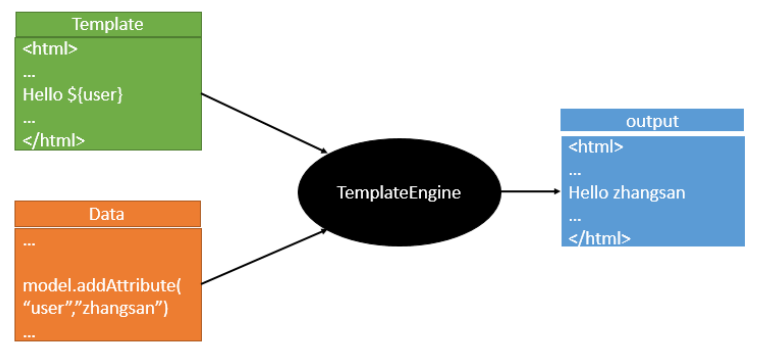
模板引擎的作用就是我们来写一个页面模板,比如有些值呢,是动态的,我们写一些表达式。而这些值,从哪来呢,我们来组装一些数据,我们把这些数据找到。然后把这个模板和这个数据交给我们模板引擎,模板引擎按照我们这个数据帮你把这表达式解析、填充到我们指定的位置,然后把这个数据最终生成一个我们想要的内容给我们写出去,这就是我们这个模板引擎,不管是jsp还是其他模板引擎,都是这个思想。
主要来介绍一下SpringBoot给我们推荐的Thymeleaf模板引擎,这模板引擎呢,是一个高级语言的模板引擎,他的这个语法更简单。而且呢,功能更强大。
第一步:引入thymeleaf :
怎么引入呢,对于springboot来说,什么事情不都是一个start的事情嘛,我们去在项目中引入一下。给大家三个网址:
1、Thymeleaf 官网:https://www.thymeleaf.org/
2、Thymeleaf 在Github 的主页:https://github.com/thymeleaf/thymeleaf
3、Spring官方文档:“https://docs.spring.io/spring-boot/docs/2.1.6.RELEASE/reference/htmlsingle/#using-boot-starter” , 找到我们对应的版本的maven依赖即可!
<!--thymeleaf模板引擎--> <dependency> <groupId>org.thymeleaf</groupId> <artifactId>thymeleaf-spring5</artifactId> </dependency> <dependency> <groupId>org.thymeleaf.extras</groupId> <artifactId>thymeleaf-extras-java8time</artifactId> </dependency>
- 查看thymeleaf.properties源码
通过前面的学习可以知道,每一个maven依赖对应的jar包都有一个对应的xxx.properties,所以我们找到thymeleaf.properties源码看一下:
@ConfigurationProperties( prefix = "spring.thymeleaf" ) public class ThymeleafProperties { private static final Charset DEFAULT_ENCODING; public static final String DEFAULT_PREFIX = "classpath:/templates/"; public static final String DEFAULT_SUFFIX = ".html"; private boolean checkTemplate = true; private boolean checkTemplateLocation = true; private String prefix = "classpath:/templates/"; private String suffix = ".html"; private String mode = "HTML"; private Charset encoding; }
我们可以在其中看到默认的前缀和后缀!我们只需要把我们的html页面放在类路径下的templates下,thymeleaf就可以帮我们自动渲染了。
我们可以去测试一下 , 写一个Controller,跳转到一个指定页面,这个指定页面需要在 类路径下的模板目录下 【演示】使用thymeleaf什么都不需要配置,只需要将他放在指定的文件夹下即可!
第二步:使用thymeleaf -取数据:
我们做个最简单的练习 : 我们需要查出一些数据,在页面中展示
我们去在controller编写一个请求,放进去一些数据;
1 @Controller 2 public class ThymeleafController { 3 @RequestMapping("/some") 4 public String demo(Model model) { 5 model.addAttribute("msg", "Hello Thymeleaf!"); 6 7 // 添加数组数据 8 String[] str = {"张三", "李四"}; 9 model.addAttribute("arr", str); 10 11 // 添加list集合 12 List list = new ArrayList<>(); 13 list.add("小二"); 14 list.add("小五"); 15 model.addAttribute("list", Arrays.asList(list)); 16 17 return "test"; 18 } 19 }
编写前端页面test.html,接收数据
1 <!DOCTYPE html> 2 <!--我们要使用thymeleaf,需要在html文件中导入命名空间的约束,方便提示--> 3 <html lang="en" xmlns:th="http://www.thymeleaf.org"> 4 <head> 5 <meta charset="UTF-8"> 6 <title>thymeleaf页面</title> 7 </head> 8 <body> 9 <!--th:text就是将div中的内容设置为它指定的值,和之前学习的Vue一样--> 10 <div th:text="${msg}"></div> 11 12 <div> 13 <!--遍历String数组--> 14 <h3 th:each="strs:${arr}" th:text="${strs}"></h3> 15 </div> 16 17 <div> 18 <!--遍历List集合--> 19 <h3 th:each="arrList:${list}" th:text="${arrList}"></h3> 20 </div> 21 22 </body> 23 </html>
结果:
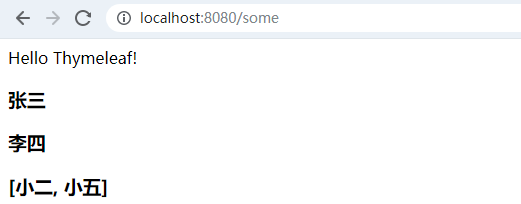
4、Thymeleaf语法
1 Selection Variable Expressions: *{...}:选择表达式:和${}在功能上是一样; 2 补充:配合 th:object="${session.user}: 3 4 <div th:object="${session.user}"> 5 <p>Name: <span th:text="*{firstName}">Sebastian</span>.</p> 6 <p>Surname: <span th:text="*{lastName}">Pepper</span>.</p> 7 <p>Nationality: <span th:text="*{nationality}">Saturn</span>.</p> 8 </div> 9 10 Message Expressions: #{...}:获取国际化内容 11 Link URL Expressions: @{...}:定义URL; 12 @{/order/process(execId=${execId},execType='FAST')} 13 14 Fragment Expressions: ~{...}:片段引用表达式 15 <div th:insert="~{commons :: main}">...</div> 16 17 Literals(字面量) 18 Text literals: 'one text' , 'Another one!' ,… 19 Number literals: 0 , 34 , 3.0 , 12.3 ,… 20 Boolean literals: true , false 21 Null literal: null 22 Literal tokens: one , sometext , main ,… 23 Text operations:(文本操作) 24 String concatenation: + 25 Literal substitutions: |The name is ${name}| 26 Arithmetic operations:(数学运算) 27 Binary operators: + , - , * , / , % 28 Minus sign (unary operator): - 29 Boolean operations:(布尔运算) 30 Binary operators: and , or 31 Boolean negation (unary operator): ! , not 32 Comparisons and equality:(比较运算) 33 Comparators: > , < , >= , <= ( gt , lt , ge , le ) 34 Equality operators: == , != ( eq , ne ) 35 Conditional operators:条件运算(三元运算符) 36 If-then: (if) ? (then) 37 If-then-else: (if) ? (then) : (else) 38 Default: (value) ?: (defaultvalue) 39 Special tokens: 40 No-Operation: _
5、了解装配MVC以及扩展MVC
官方建议:直接创建一个MVCconfig类,在类上加上 @Configuration 注解,并且实现WebMvcConfigurer接口,并且不能使用 @EnableWebMvc 注解
为什么不能使用 @EnableWebMvc 注解
-
这个注解导入了一个类:DelegatingWebMvcConfiguration,这个类从容器中获取所有的webmvcconfig
并且在WebMvcAutoConfiguration类中有这样一个注解:
@ConditionalOnMissingBean(WebMvcConfigurationSupport.class)
-
这个注解的意思就是:容器中没有这个组件的时候,这个自动配置类才生效
-
如果加了 @EnableWebMVC 容器中就有了组件,这个配置就不生效了
如果需要全面接管SpringMVC可以使用该注解,当然在开发中,不推荐使用全面接管SpringMVC
扩展:在springboot中,有非常多的xxxx Configuration帮助我们进行扩展配置、
通常我们的添加功能扩展的类都是在config包下,而视图的跳转页面则放到templates包下:
自定义一个视图解析器实现页面的跳转:
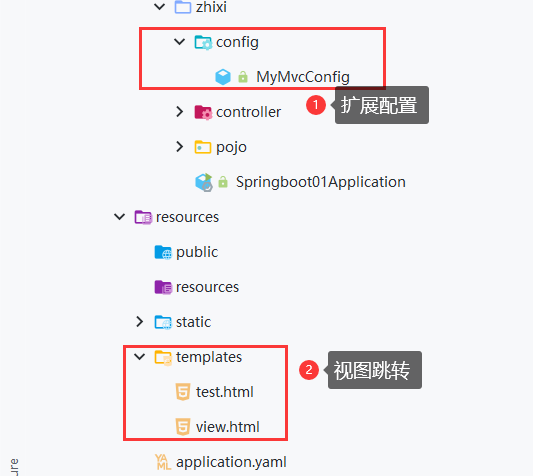
1 /** 2 * 扩展:自定义spring DispatcherServlet(视图解析器) 3 * 如果你想diy一些定制化的功能, 只要写这个组件,然后将它交给springboot, springboot就会帮我们自动装配! 4 */ 5 @Configuration 6 public class MyMvcConfig implements WebMvcConfigurer { 7 8 @Override 9 /*添加视图控制器*/ 10 public void addViewControllers(ViewControllerRegistry registry) { 11 // 如果视图控制器走/zhixi,就会跳转到view.html页面 12 registry.addViewController("/zhixi").setViewName("view"); 13 } 14 }
6、前端基础
如果你想定义你的404错误,就要将你的404.html页面放到templates/error/下
准备工作:
-
准备好模版(在网上找bootstrap或其他的模版,或者自己写)
-
页面直接放在templates下,css、img、js等放在static下
-
修改html页面,使其符合Thymeleaf模版规范
- 在url路径属性前增加
th:并修改url路径为@{}格式(js、css、img等)
- 在url路径属性前增加
4. 准备数据
在这里用Map模拟数据库中的数据,后期再进行数据库整合。
pojo实体类:
用户表:

1 package com.zhixi.pojo; 2 3 import lombok.AllArgsConstructor; 4 import lombok.Data; 5 import lombok.NoArgsConstructor; 6 import org.springframework.stereotype.Repository; 7 8 /** 9 * @author zhangzhixi 10 */ 11 @Data 12 @AllArgsConstructor 13 @NoArgsConstructor 14 public class User { 15 private Integer id; 16 private String name; 17 private int age; 18 // 员工部门 19 private Department department; 20 }
部门表:

package com.zhixi.pojo; import lombok.AllArgsConstructor; import lombok.Data; import lombok.NoArgsConstructor; /** * @author zhangzhixi * 部门表 */ @Data @AllArgsConstructor @NoArgsConstructor public class Department { private Integer id; private String departmentName; }
dao层业务:
UserDao:

package com.zhixi.dao; import com.zhixi.pojo.Department; import com.zhixi.pojo.User; import org.springframework.beans.factory.annotation.Autowired; import org.springframework.stereotype.Repository; import java.util.Collection; import java.util.HashMap; import java.util.Map; /** * @author zhangzhixi */ @Repository public class UserDao { //模拟数据库中的数据 private static Map<Integer, User> userMap = null; @Autowired // 员工所属的部门 private static DepartmentDao departmentDao; static { //模拟数据库中的数据 userMap = new HashMap<Integer, User>(); userMap.put(101, new User(1001, "张三", 21, new Department(101, "教学部"))); userMap.put(102, new User(1002, "李四", 22, new Department(102, "市场部"))); userMap.put(103, new User(1003, "王五", 23, new Department(103, "后勤部"))); } // 主键自增 private static Integer initId = 1004; // 添加一个用户 public void addUser(User user) { userMap.put(initId++, user); } // 查询全部员工 public Collection<User> getUsers(){ return userMap.values(); } // 通过id查询员工 public User getUserById(Integer id){ return userMap.get(id); } // 删除一个员工 public void delUser(Integer id){ userMap.remove(id); } }
DepartmentDao:

1 package com.zhixi.dao; 2 3 import com.zhixi.pojo.Department; 4 import org.springframework.stereotype.Repository; 5 6 import java.util.Collection; 7 import java.util.HashMap; 8 import java.util.Map; 9 10 /** 11 * @author zhangzhixi 12 * 部门dao 13 */ 14 // 相当于Component注解 15 @Repository 16 public class DepartmentDao { 17 private static Map<Integer, Department> Departments = null; 18 19 static { 20 //模拟数据库中的数据 21 Departments = new HashMap<Integer, Department>();//创建一个部门表 22 Departments.put(101, new Department(101, "教学部")); 23 Departments.put(102, new Department(102, "市场部")); 24 Departments.put(103, new Department(103, "后勤部")); 25 Departments.put(104, new Department(104, "教研部")); 26 } 27 28 //获得所有部门信息 29 public Collection<Department> getDepartments() { 30 return Departments.values(); 31 } 32 33 // 根据id查询部门 34 public Department getDepartmentById(Integer id) { 35 return Departments.get(id); 36 } 37 }
首页实现
要求:默认访问首页
方式一:写一个controller实现!
1 //会解析到templates目录下的index.html页面 2 @RequestMapping({"/","/index.html"}) 3 public String index(){ 4 return "index"; 5 }
方式二:自己编写MVC的扩展配置
1 @Configuration 2 public class MyMVCConfig implements WebMvcConfigurer { 3 @Override 4 public void addViewControllers(ViewControllerRegistry registry) { 5 //param1:路径,param2:名称 6 registry.addViewController("/").setViewName("index"); 7 registry.addViewController("/index.html").setViewName("index"); 8 } 9 }
解决了这个问题,我们还需要解决一个资源导入的问题;
为了保证资源导入稳定,我们建议在所有资源导入时候使用 th:去替换原有的资源路径!
1 <!--“/”默认就是statics目录--> 2 <link th:href="@{/css/style.css}" rel="stylesheet" /> 3 4 </head> 5 <body> 6 7 <script th:src="@{/js/anime.min.js}"></script>
7、项目国际化
1、在页面设置按钮发送请求,并修改页面文字元素为thymeleaf格式
注意踩坑,这里的index不带后缀名
<!--设置语言切换-->
<a class="btn btn-sm" th:href="@{/index(l='zh_CN')}">中文</a>
<a class="btn btn-sm" th:href="@{/index(l='en_US')}">English</a>
2、在resources下创建i18n文件夹,并创建login.proterties文件login_zh_CN.proterties文件login_en_US.proterties文件并写入数据
login.tip=请登录 login.username=用户名 login.password=密码 login.remember=保存密码 login.btn=登录 login.tip=请登录 login.username=用户名 login.password=密码 login.remember=保存密码 login.btn=登录 login.tip=please sign in login.username=username login.password=userpassword login.remember=save pwd login.btn=login
3、在核心配置文件中配置一下属性
# 国际化配置文件的真实位置 spring.messages.basename=iI18n.login
4、在config包内创建类,实现localereslover接口,重写方法,解析请求
1 package com.zhixi.config; 2 3 import org.springframework.util.StringUtils; 4 import org.springframework.web.servlet.LocaleResolver; 5 6 import javax.servlet.http.HttpServletRequest; 7 import javax.servlet.http.HttpServletResponse; 8 import java.util.Locale; 9 10 /** 11 * @author zhangzhixi 12 * 编写语言解析器设置 13 */ 14 public class MyLocalResolver implements LocaleResolver { 15 @Override 16 public Locale resolveLocale(HttpServletRequest request) { 17 // 获取到首页传来的语言版本 18 String language = request.getParameter("l"); 19 // 识别语言版本,没有就使用默认的 20 Locale locale = Locale.getDefault(); 21 System.out.println("========>" + language); 22 // 请求参数携带了国际化参数,将语言zh_CH进行分割 23 if (!StringUtils.isEmpty(language)) { 24 System.out.println("=============="); 25 String[] split = language.split("_"); 26 // 设置国家和地区 27 System.out.println(split[0]); 28 System.out.println(split[1]); 29 locale = new Locale(split[0], split[1]); 30 } 31 return locale; 32 } 33 @Override 34 public void setLocale(HttpServletRequest httpServletRequest, HttpServletResponse httpServletResponse, Locale locale) { 35 } 36 }
5、在mvcconfig配置Bean
注意踩坑,这里的方法名必须是localeResolver
// 注册语言解析器
@Bean
public LocaleResolver localeResolver(){
return new MyLocalResolver();
}
6、测试运行
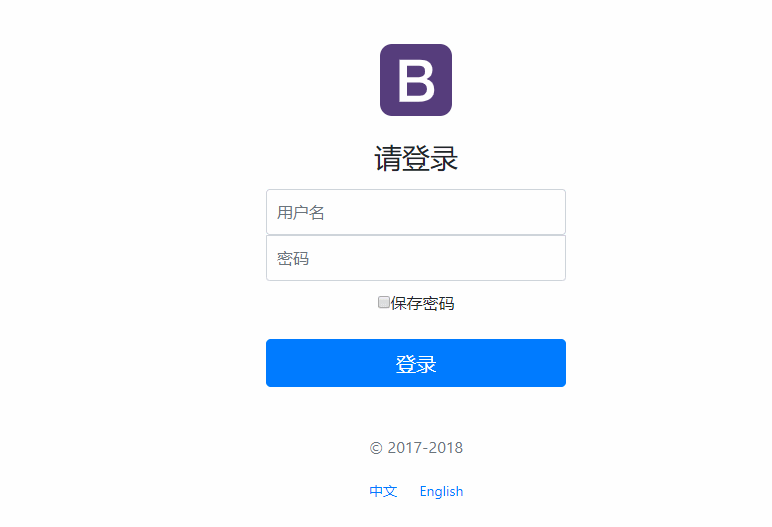
附:index首页代码

1 <!DOCTYPE html> 2 <html lang="en" xmlns:th="http://www.thymeleaf.org"> 3 <head> 4 <meta http-equiv="Content-Type" content="text/html; charset=UTF-8"> 5 <meta name="viewport" content="width=device-width, initial-scale=1, shrink-to-fit=no"> 6 <meta name="description" content=""> 7 <meta name="author" content=""> 8 <title>Signin Template for Bootstrap</title> 9 <link th:href="@{/css/bootstrap.min.css}" rel="stylesheet"> 10 <link th:href="@{/css/signin.css}" rel="stylesheet"> 11 </head> 12 13 <body class="text-center"> 14 <form class="form-signin" action="dashboard.html"> 15 <img class="mb-4" th:src="@{/img/bootstrap-solid.svg}" alt="" width="72" height="72"> 16 17 18 <!--请登录--> 19 <h1 class="h3 mb-3 font-weight-normal" th:text="#{login.tip}">Please sign in</h1> 20 <!--账号密码--> 21 <input type="text" class="form-control" th:placeholder="#{login.username}" required="" autofocus=""> 22 <input type="password" class="form-control" th:placeholder="#{login.password}" required=""> 23 24 <div class="checkbox mb-3"> 25 <label> 26 <!--记住密码--> 27 <input type="checkbox" value="remember">[[#{login.remember}]] 28 </label> 29 </div> 30 <!--登录--> 31 <button class="btn btn-lg btn-primary btn-block" type="submit">[[#{login.btn}]]</button> 32 <p class="mt-5 mb-3 text-muted">© 2017-2018</p> 33 <!--设置语言切换--> 34 <a class="btn btn-sm" th:href="@{/index(l='zh_CN')}">中文</a> 35 <a class="btn btn-sm" th:href="@{/index(l='en_US')}">English</a> 36 </form> 37 38 </body> 39 40 </html>
8、登录+拦截器功能实现
登录:
1、这里就先不连接数据库了,输入任意用户名都可以登录成功!
声明一个之前没有提到的问题: templates下的页面只能通过Controller跳转实现,而static下的页面是能直接被外界访问的,就能正常访问了。
我们把登录页面的表单提交地址写一个controller!
<form class="form" th:action="@{/user/login}" method="post">
2、去编写对应的controller
@Controller
public class LoginController {
@RequestMapping("/user/login")
public String login(
@RequestParam("username") String username,
@RequestParam("password") String password,
Model model,) {
if (username != null && "123".equals(password)) {
// 重定向到controller请求中
return "redirect:/main.html";
} else {
// 告诉用户登录失败
model.addAttribute("msg", "用户名或者密码错误");
return "index";
}
}
}
3、关闭页面缓存
页面存在缓存,所以我们需要禁用模板引擎的缓存
#禁用模板缓存spring.thymeleaf.cache=false
4、给出用户登录失败提示
<!--判断是否显示,使用if, ${}可以使用工具类,可以看thymeleaf的中文文档-->
<p style="color: red" th:text="${msg}" th:if="${not #strings.isEmpty(msg)}"></p>
5、在MVCConfig中添加视图控制映射
能够在第2步中的redirect中能够跳转到对应的页面
// 接收请求,转到页面
registry.addViewController("/main.html").setViewName("dashboard");
6、登录测试
成功:

失败:
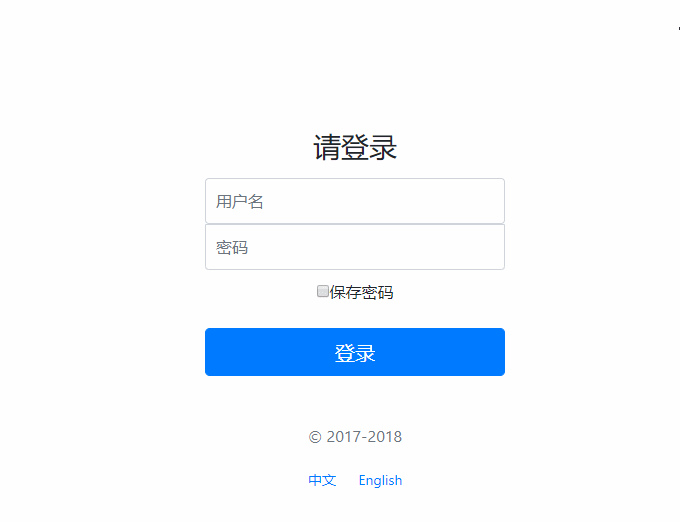
模板引擎修改后,想要实时生效!页面修改完毕后,IDEA小技巧 : Ctrl + F9 重新编译!
拦截器:HandlerInterceptor
重定向成功之后!我们解决了之前资源没有加载进来的问题!后台主页正常显示!
但是又发现新的问题,我们可以直接登录到后台主页,不用登录也可以实现!
怎么处理这个问题呢?我们可以使用拦截器机制,实现登录检查!
1、config包中自定义拦截器:
public class LoginHandlerInterceptor implements HandlerInterceptor {
@Override
public boolean preHandle(HttpServletRequest request, HttpServletResponse response, Object handler) throws Exception {
Object login = request.getSession().getAttribute("login");
// 提示用户没有登录成功
if (login == null) {
request.setAttribute("msg", "没有权限,请先登录!");
request.getRequestDispatcher("/index").forward(request, response);
return false;
}
return true;
}
}
2、将拦截器注册到我们的SpringMVC配置类当中!
// 拦截器设置
@Override
public void addInterceptors(InterceptorRegistry registry) {
registry.addInterceptor(new LoginHandlerInterceptor())
// 拦截所有请求
.addPathPatterns("/**")
// 放行指定路径
.excludePathPatterns("/", "/index", "/user/login", "/css/*", "/js/*");
}
3、测试,直接访问主页
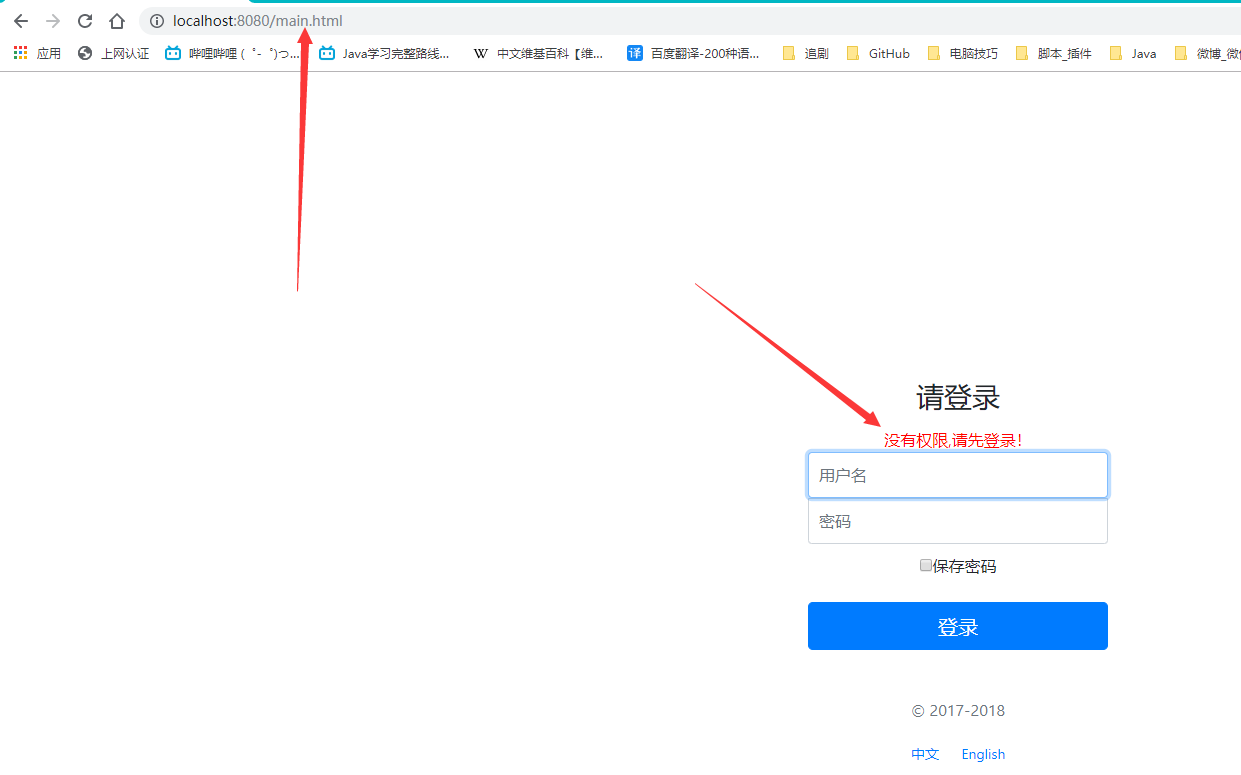
9、展示用户页
1、首页点击用户后进行跳转
<li class="nav-item">
<!--请求路径就到controller中-->
<a class="nav-link" th:href="@{/emps}">
员工
</a>
</li>
2、定义一个controller类来实现处理请求数据的功能
@Controller
public class UserController {
@Autowired
private UserDao userDao;
@RequestMapping("/emps")
public String list(Model model) {
// 调用dao层业务方法获取全部用户
Collection<User> users = userDao.getUsers();
// model携带用户数据
model.addAttribute("emp", users);
// 跳转到list页面展示
return "emp/list";
}
}
3、在list页面中定义表格,将获取到的数据通过thymeleaf显示出来
<div class="table-responsive">
<table class="table table-striped table-sm">
<thead>
<tr>
<th>编号</th>
<th>姓名</th>
<th>年龄</th>
<th>部门编号</th>
<th>部门名称</th>
<th>操作</th>
</tr>
</thead>
<tbody>
<tr th:each="emps:${emp}">
<td th:text="${emps.getId()}"></td>
<td th:text="${emps.getName()}"></td>
<td th:text="${emps.getAge()}"></td>
<td th:text="${emps.getDepartment().getId()}"></td>
<td th:text="${emps.getDepartment().getDepartmentName()}"></td>
<td>
<button class="btn btn-sm btn-primary">编辑</button>
<button class="btn btn-sm btn-danger">删除</button>
</td>
</tr>
</tbody>
</table>
</div>

10、添加员工
1、在用户展示的list页面添加跳转到添加员工页面
<!--添加员工-->
<h2></h2><a class="btn btn-sm btn-success" th:href="@{/emp}">添加员工</a>
2、编写controller跳转到添加用户页面
// 添加用户界面
@GetMapping("/emp")
public String addUser(Model model) {
// 查出所有部门的信息
Collection<Department> departments = departmentDao.getDepartments();
model.addAttribute("departments", departments);
// 请求到add页面
return "emp/add";
}
3、add页面添加表单数据:注意name属性要跟字段一致,否则表单不会将数据进行提交
<form th:action="@{/emp}" method="post">
<div class="form-group">
<label>员工姓名</label>
<input type="text" class="form-control" placeholder="xxx" name="name">
</div>
<div class="form-group">
<label>员工年龄</label>
<input type="text" class="form-control" placeholder="xxx" name="age">
</div>
<div class="form-group">
<label>员工部门</label>
<select class="form-control" name="department.id">
<option th:each="dept:${departments}" th:text="${dept.getDepartmentName()}" th:value="${dept.getId()}"></option>
</select>
</div>
<button type="submit" class="btn btn-primary">添加</button>
</form>

4、添加用户成功跳转到查询全部员工界面
// 添加用户成功请求(跳转到首页)
@PostMapping("/emp")
public String addEmp(User user) {
// 用户点击添加按钮,底层执行添加操作
System.out.println("add==>" + user);
userDao.addUser(user);
// 重定向到查询全部用户界面
return "redirect:/emps";
}
